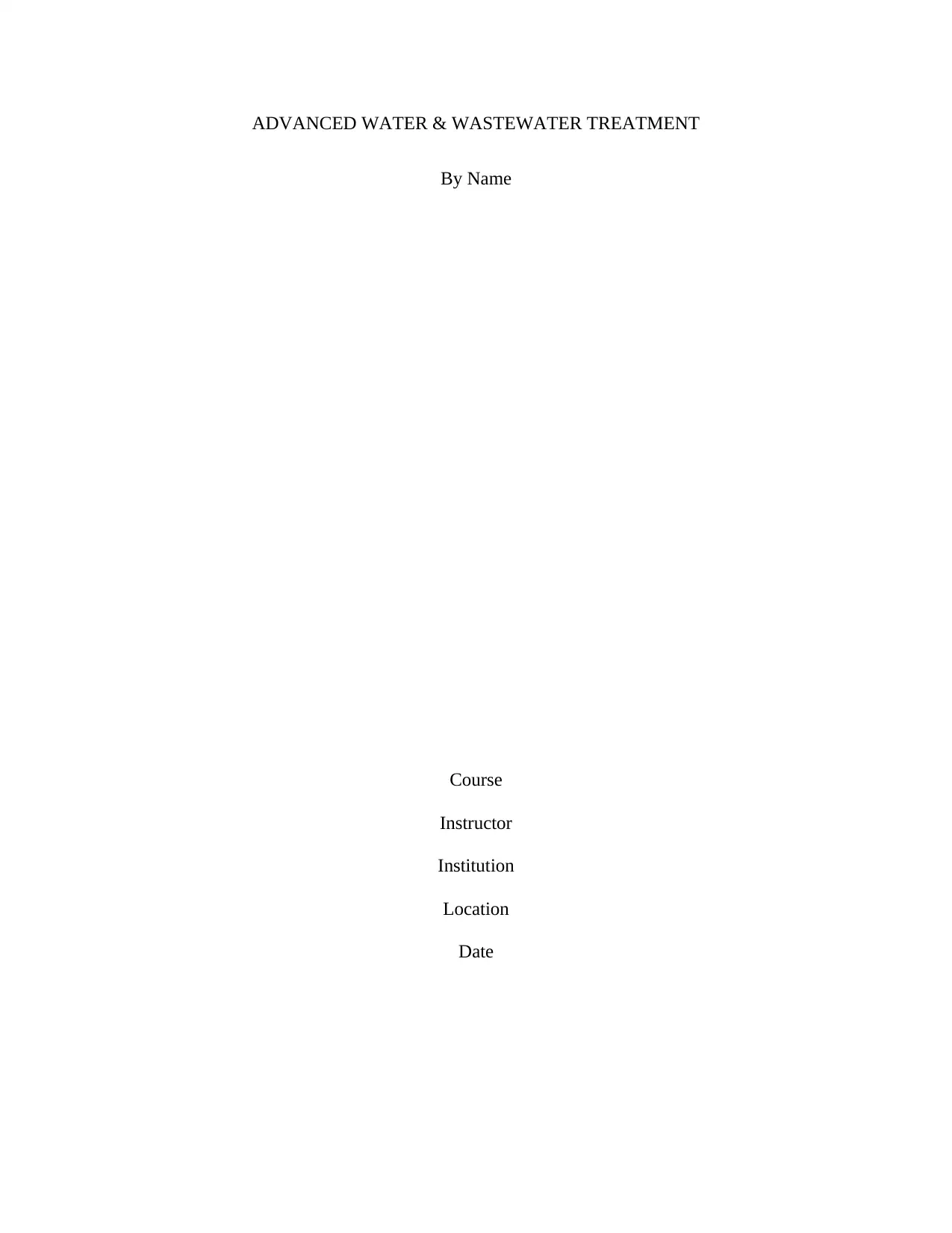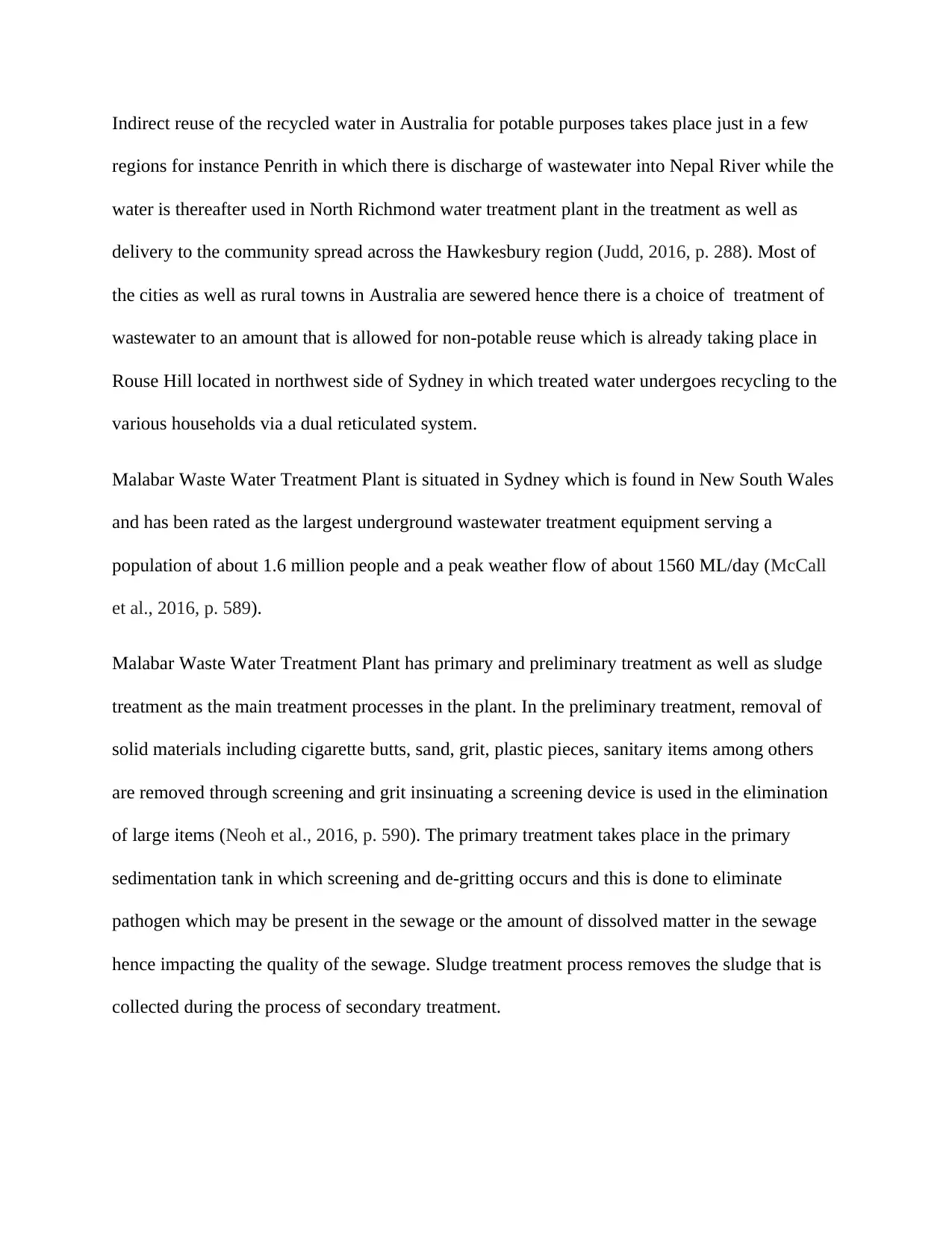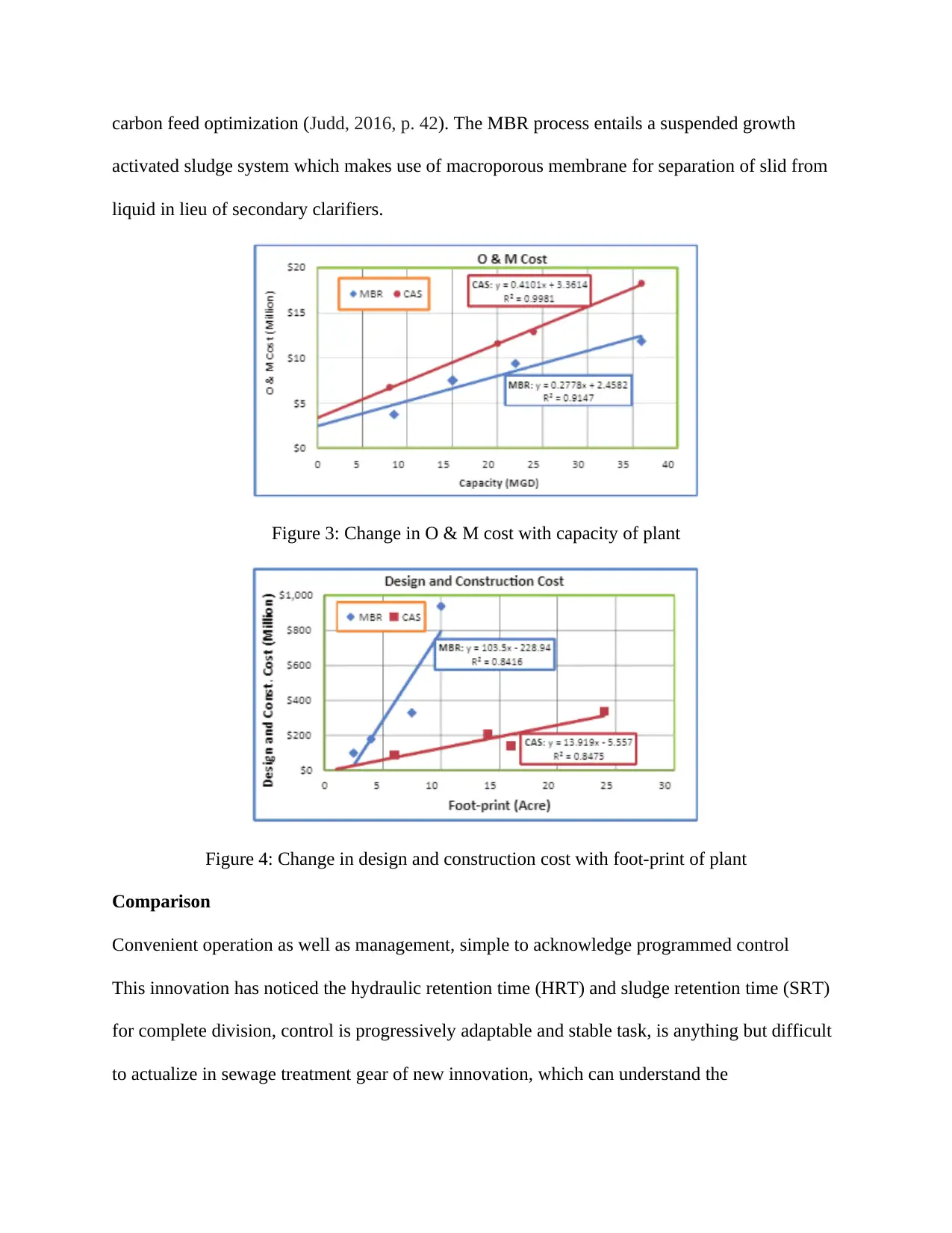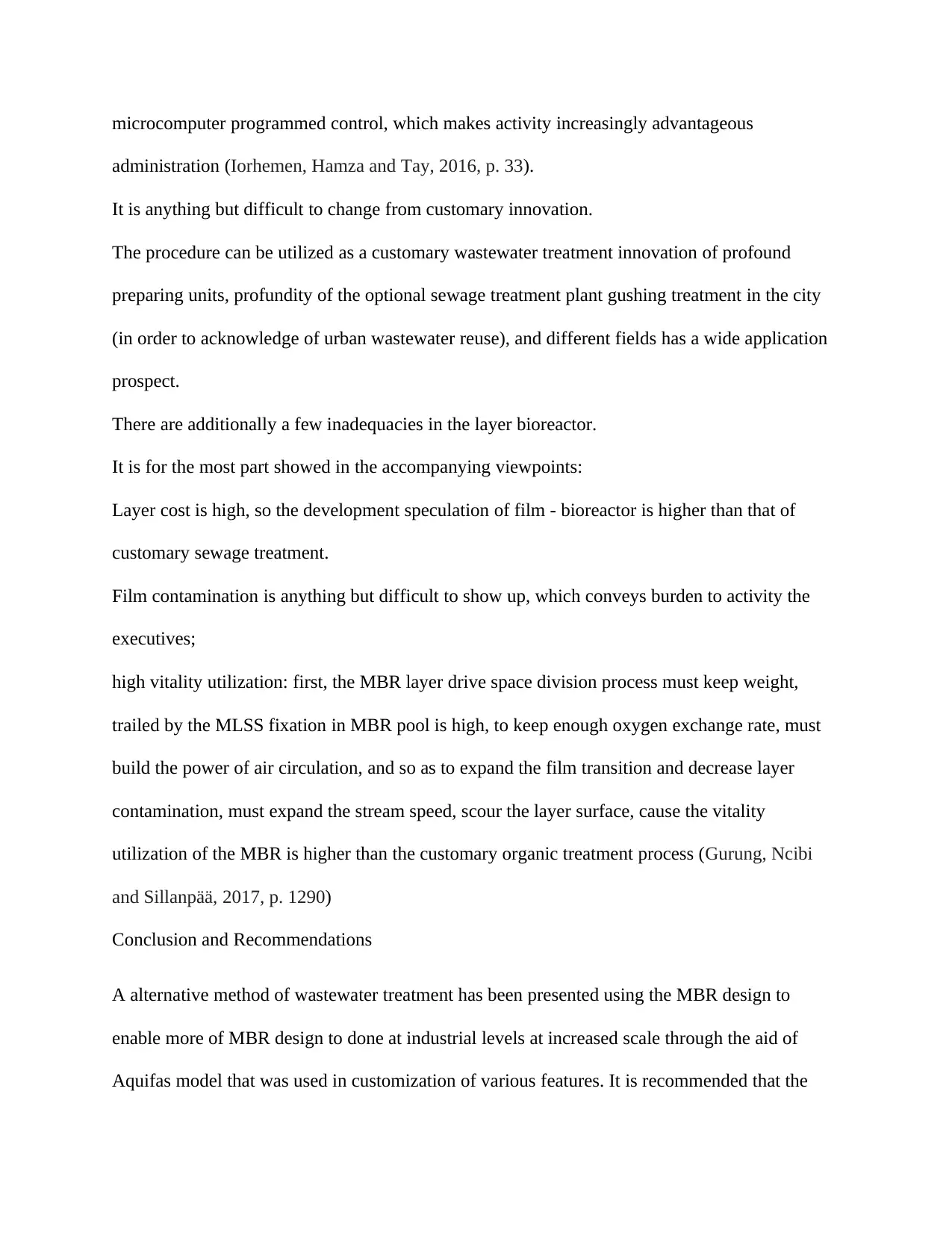Advanced Water & Wastewater Treatment with MBR Process
VerifiedAdded on 2022/11/13
|8
|1451
|385
AI Summary
This study aims at improving the efficiency and cost of water treatment at the Malabar Waste Water Treatment Plant through the introduction of MBR process. The alternative design comes along with numerous control and optimization of the features of MBR process on the Aquifas model which aimed at enhancing aeration as well as air scour energy optimization alongside optimization of recycling rate and supplemental carbon feed optimization.
Contribute Materials
Your contribution can guide someone’s learning journey. Share your
documents today.

ADVANCED WATER & WASTEWATER TREATMENT
By Name
Course
Instructor
Institution
Location
Date
By Name
Course
Instructor
Institution
Location
Date
Secure Best Marks with AI Grader
Need help grading? Try our AI Grader for instant feedback on your assignments.

Abstract
Most of the Australians’ drinking water which falls on land gathered in dams, transported to the
various reservoirs and then taken through treatment to eliminate solids as well as kills pathogens
and thereafter distributed to the large community through networks of pipes. Indirect reuse of the
recycled water in Australia for potable purposes takes place just in a few regions. Malabar Waste
Water Treatment Plant has primary and preliminary treatment as well as sludge treatment as the
main treatment processes in the plant. This study aims at improving the efficiency and cost of
water treatment at the Malabar Waste Water Treatment Plant through the introduction of MBR
process. The alternative design comes along with numerous control and optimization of the
features of MBR process on the Aquifas model which aimed at enhancing aeration as well as air
scour energy optimization alongside optimization of recycling rate and supplemental carbon feed
optimization. The study findings established that the use of Aquifas model on MBR process
provided an alternative way of efficiently and cost effectively treatment waste water at the
Malabar Waste Water Treatment Plant.
Background
Most of the Australians’ drinking water which falls on land gathered in dams, transported to the
various reservoirs and then taken through treatment to eliminate solids as well as kills pathogens
and thereafter distributed to the large community through networks of pipes. Most of the urban
regions in Australia are sewered having waste water from various houses, returns, and industry
as well as commercial units. Normally, a section of stormwater as well gets into the sewers. Such
wastewater is often known as sewage and is taken to the sewage transport plants in which it
undergoes treatment to various levels of quality depending on the regional location of the sewage
treatment plant.
Most of the Australians’ drinking water which falls on land gathered in dams, transported to the
various reservoirs and then taken through treatment to eliminate solids as well as kills pathogens
and thereafter distributed to the large community through networks of pipes. Indirect reuse of the
recycled water in Australia for potable purposes takes place just in a few regions. Malabar Waste
Water Treatment Plant has primary and preliminary treatment as well as sludge treatment as the
main treatment processes in the plant. This study aims at improving the efficiency and cost of
water treatment at the Malabar Waste Water Treatment Plant through the introduction of MBR
process. The alternative design comes along with numerous control and optimization of the
features of MBR process on the Aquifas model which aimed at enhancing aeration as well as air
scour energy optimization alongside optimization of recycling rate and supplemental carbon feed
optimization. The study findings established that the use of Aquifas model on MBR process
provided an alternative way of efficiently and cost effectively treatment waste water at the
Malabar Waste Water Treatment Plant.
Background
Most of the Australians’ drinking water which falls on land gathered in dams, transported to the
various reservoirs and then taken through treatment to eliminate solids as well as kills pathogens
and thereafter distributed to the large community through networks of pipes. Most of the urban
regions in Australia are sewered having waste water from various houses, returns, and industry
as well as commercial units. Normally, a section of stormwater as well gets into the sewers. Such
wastewater is often known as sewage and is taken to the sewage transport plants in which it
undergoes treatment to various levels of quality depending on the regional location of the sewage
treatment plant.

Indirect reuse of the recycled water in Australia for potable purposes takes place just in a few
regions for instance Penrith in which there is discharge of wastewater into Nepal River while the
water is thereafter used in North Richmond water treatment plant in the treatment as well as
delivery to the community spread across the Hawkesbury region (Judd, 2016, p. 288). Most of
the cities as well as rural towns in Australia are sewered hence there is a choice of treatment of
wastewater to an amount that is allowed for non-potable reuse which is already taking place in
Rouse Hill located in northwest side of Sydney in which treated water undergoes recycling to the
various households via a dual reticulated system.
Malabar Waste Water Treatment Plant is situated in Sydney which is found in New South Wales
and has been rated as the largest underground wastewater treatment equipment serving a
population of about 1.6 million people and a peak weather flow of about 1560 ML/day (McCall
et al., 2016, p. 589).
Malabar Waste Water Treatment Plant has primary and preliminary treatment as well as sludge
treatment as the main treatment processes in the plant. In the preliminary treatment, removal of
solid materials including cigarette butts, sand, grit, plastic pieces, sanitary items among others
are removed through screening and grit insinuating a screening device is used in the elimination
of large items (Neoh et al., 2016, p. 590). The primary treatment takes place in the primary
sedimentation tank in which screening and de-gritting occurs and this is done to eliminate
pathogen which may be present in the sewage or the amount of dissolved matter in the sewage
hence impacting the quality of the sewage. Sludge treatment process removes the sludge that is
collected during the process of secondary treatment.
regions for instance Penrith in which there is discharge of wastewater into Nepal River while the
water is thereafter used in North Richmond water treatment plant in the treatment as well as
delivery to the community spread across the Hawkesbury region (Judd, 2016, p. 288). Most of
the cities as well as rural towns in Australia are sewered hence there is a choice of treatment of
wastewater to an amount that is allowed for non-potable reuse which is already taking place in
Rouse Hill located in northwest side of Sydney in which treated water undergoes recycling to the
various households via a dual reticulated system.
Malabar Waste Water Treatment Plant is situated in Sydney which is found in New South Wales
and has been rated as the largest underground wastewater treatment equipment serving a
population of about 1.6 million people and a peak weather flow of about 1560 ML/day (McCall
et al., 2016, p. 589).
Malabar Waste Water Treatment Plant has primary and preliminary treatment as well as sludge
treatment as the main treatment processes in the plant. In the preliminary treatment, removal of
solid materials including cigarette butts, sand, grit, plastic pieces, sanitary items among others
are removed through screening and grit insinuating a screening device is used in the elimination
of large items (Neoh et al., 2016, p. 590). The primary treatment takes place in the primary
sedimentation tank in which screening and de-gritting occurs and this is done to eliminate
pathogen which may be present in the sewage or the amount of dissolved matter in the sewage
hence impacting the quality of the sewage. Sludge treatment process removes the sludge that is
collected during the process of secondary treatment.

Figure 1: Current process layout diagram for water treatment
Aquifas technology would be used as an alternative treatment process design in which
customization will be conducted to enable a faster as well as reliable design which is as well
optimized in attaining lower as well as flexible footprint in ensuring the plant fits in the available
area
Figure 2: Illustration of alternative design process layout diagram
The alternative design comes along with numerous control and optimization of the features of
MBR process on the Aquifas model. These modifications are aimed at enhancing aeration as
well as air scour energy optimization alongside optimization of recycling rate and supplemental
Aquifas technology would be used as an alternative treatment process design in which
customization will be conducted to enable a faster as well as reliable design which is as well
optimized in attaining lower as well as flexible footprint in ensuring the plant fits in the available
area
Figure 2: Illustration of alternative design process layout diagram
The alternative design comes along with numerous control and optimization of the features of
MBR process on the Aquifas model. These modifications are aimed at enhancing aeration as
well as air scour energy optimization alongside optimization of recycling rate and supplemental
Secure Best Marks with AI Grader
Need help grading? Try our AI Grader for instant feedback on your assignments.

carbon feed optimization (Judd, 2016, p. 42). The MBR process entails a suspended growth
activated sludge system which makes use of macroporous membrane for separation of slid from
liquid in lieu of secondary clarifiers.
Figure 3: Change in O & M cost with capacity of plant
Figure 4: Change in design and construction cost with foot-print of plant
Comparison
Convenient operation as well as management, simple to acknowledge programmed control
This innovation has noticed the hydraulic retention time (HRT) and sludge retention time (SRT)
for complete division, control is progressively adaptable and stable task, is anything but difficult
to actualize in sewage treatment gear of new innovation, which can understand the
activated sludge system which makes use of macroporous membrane for separation of slid from
liquid in lieu of secondary clarifiers.
Figure 3: Change in O & M cost with capacity of plant
Figure 4: Change in design and construction cost with foot-print of plant
Comparison
Convenient operation as well as management, simple to acknowledge programmed control
This innovation has noticed the hydraulic retention time (HRT) and sludge retention time (SRT)
for complete division, control is progressively adaptable and stable task, is anything but difficult
to actualize in sewage treatment gear of new innovation, which can understand the

microcomputer programmed control, which makes activity increasingly advantageous
administration (Iorhemen, Hamza and Tay, 2016, p. 33).
It is anything but difficult to change from customary innovation.
The procedure can be utilized as a customary wastewater treatment innovation of profound
preparing units, profundity of the optional sewage treatment plant gushing treatment in the city
(in order to acknowledge of urban wastewater reuse), and different fields has a wide application
prospect.
There are additionally a few inadequacies in the layer bioreactor.
It is for the most part showed in the accompanying viewpoints:
Layer cost is high, so the development speculation of film - bioreactor is higher than that of
customary sewage treatment.
Film contamination is anything but difficult to show up, which conveys burden to activity the
executives;
high vitality utilization: first, the MBR layer drive space division process must keep weight,
trailed by the MLSS fixation in MBR pool is high, to keep enough oxygen exchange rate, must
build the power of air circulation, and so as to expand the film transition and decrease layer
contamination, must expand the stream speed, scour the layer surface, cause the vitality
utilization of the MBR is higher than the customary organic treatment process (Gurung, Ncibi
and Sillanpää, 2017, p. 1290)
Conclusion and Recommendations
A alternative method of wastewater treatment has been presented using the MBR design to
enable more of MBR design to done at industrial levels at increased scale through the aid of
Aquifas model that was used in customization of various features. It is recommended that the
administration (Iorhemen, Hamza and Tay, 2016, p. 33).
It is anything but difficult to change from customary innovation.
The procedure can be utilized as a customary wastewater treatment innovation of profound
preparing units, profundity of the optional sewage treatment plant gushing treatment in the city
(in order to acknowledge of urban wastewater reuse), and different fields has a wide application
prospect.
There are additionally a few inadequacies in the layer bioreactor.
It is for the most part showed in the accompanying viewpoints:
Layer cost is high, so the development speculation of film - bioreactor is higher than that of
customary sewage treatment.
Film contamination is anything but difficult to show up, which conveys burden to activity the
executives;
high vitality utilization: first, the MBR layer drive space division process must keep weight,
trailed by the MLSS fixation in MBR pool is high, to keep enough oxygen exchange rate, must
build the power of air circulation, and so as to expand the film transition and decrease layer
contamination, must expand the stream speed, scour the layer surface, cause the vitality
utilization of the MBR is higher than the customary organic treatment process (Gurung, Ncibi
and Sillanpää, 2017, p. 1290)
Conclusion and Recommendations
A alternative method of wastewater treatment has been presented using the MBR design to
enable more of MBR design to done at industrial levels at increased scale through the aid of
Aquifas model that was used in customization of various features. It is recommended that the

design and water treatment requirements be considered to ensure maximization of output and
minimization of costs, energy as well as space provisions.
minimization of costs, energy as well as space provisions.
Paraphrase This Document
Need a fresh take? Get an instant paraphrase of this document with our AI Paraphraser

References
Down, S.A., Galliano, F., Honks, J., Johnson, D., Yalcinkaya, S.A., Gabriele, B., Helal, N.,
Drily, E. and Gigolo, A., 2016. Novel low-fouling membrane bioreactor (MBR) for industrial
wastewater treatment. Journal of membrane science, 510, pp.524-532
Gurung, K., Ncibi, M.C. and Sillanpää, M., 2017. Assessing membrane fouling and the
performance of pilot-scale membrane bioreactor (MBR) to treat real municipal wastewater
during winter season in Nordic regions. Science of the Total Environment, 579, pp.1289-1297
Iorhemen, O., Hamza, R. and Tay, J., 2016. Membrane bioreactor (MBR) technology for
wastewater treatment and reclamation: membrane fouling. Membranes, 6(2), p.33
Judd, S.J., 2016. The status of industrial and municipal effluent treatment with membrane
bioreactor technology. Chemical Engineering Journal, 305, pp.37-45
McCall, C., Munir, M., Marsh, T. and Xagoraraki, I., 2016. Metagenomic Analysis of Antibiotic
Resistant Genes in a Conventional and Membrane Bioreactor Wastewater Treatment Plant.
Michigan State University. Environmental Engineering
Neoh, C.H., Noor, Z.Z., Mutamim, N.S.A. and Lim, C.K., 2016. Green technology in wastewater
treatment technologies: integration of membrane bioreactor with various wastewater treatment
systems. Chemical engineering journal, 283, pp.582-594
Down, S.A., Galliano, F., Honks, J., Johnson, D., Yalcinkaya, S.A., Gabriele, B., Helal, N.,
Drily, E. and Gigolo, A., 2016. Novel low-fouling membrane bioreactor (MBR) for industrial
wastewater treatment. Journal of membrane science, 510, pp.524-532
Gurung, K., Ncibi, M.C. and Sillanpää, M., 2017. Assessing membrane fouling and the
performance of pilot-scale membrane bioreactor (MBR) to treat real municipal wastewater
during winter season in Nordic regions. Science of the Total Environment, 579, pp.1289-1297
Iorhemen, O., Hamza, R. and Tay, J., 2016. Membrane bioreactor (MBR) technology for
wastewater treatment and reclamation: membrane fouling. Membranes, 6(2), p.33
Judd, S.J., 2016. The status of industrial and municipal effluent treatment with membrane
bioreactor technology. Chemical Engineering Journal, 305, pp.37-45
McCall, C., Munir, M., Marsh, T. and Xagoraraki, I., 2016. Metagenomic Analysis of Antibiotic
Resistant Genes in a Conventional and Membrane Bioreactor Wastewater Treatment Plant.
Michigan State University. Environmental Engineering
Neoh, C.H., Noor, Z.Z., Mutamim, N.S.A. and Lim, C.K., 2016. Green technology in wastewater
treatment technologies: integration of membrane bioreactor with various wastewater treatment
systems. Chemical engineering journal, 283, pp.582-594
1 out of 8
Your All-in-One AI-Powered Toolkit for Academic Success.
+13062052269
info@desklib.com
Available 24*7 on WhatsApp / Email
![[object Object]](/_next/static/media/star-bottom.7253800d.svg)
Unlock your academic potential
© 2024 | Zucol Services PVT LTD | All rights reserved.